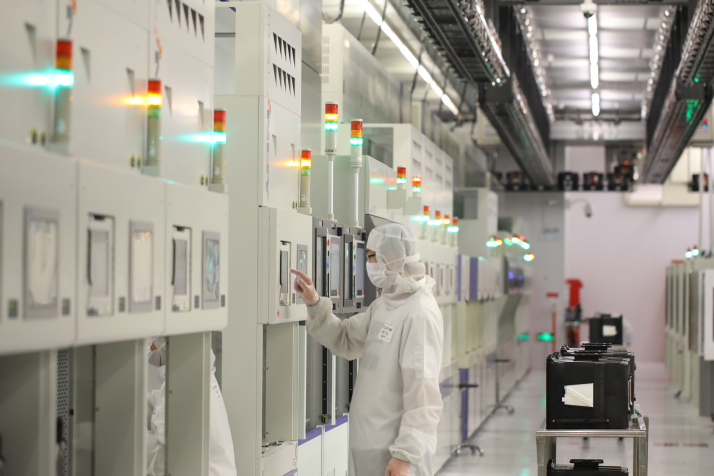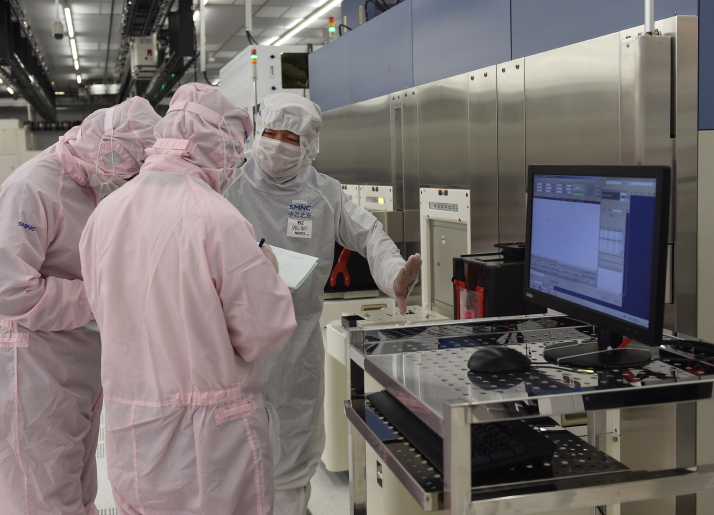| Business |
| Mega semiconductor firm's domestic listing adds power to Chinese hi-tech manufacturing | |
|
|
 SMIC's workshop in the Beijing Economic-Technological Development Area on February 18 (XINHUA)
Semiconductor Manufacturing International Corp. (SMIC), China's largest semiconductor foundry, listed on the one-year-old Science and Technology Innovation Board of Shanghai Stock Exchange (SSE), popularly known as the STAR Market, on July 16, becoming the first Chinese technology firm to list both on the Chinese mainland and Hong Kong Special Administrative Region. On the first day of trading, SMIC's share price closed at 82.92 yuan ($11.86), surging by 201.97 percent from its issuing price of 27.46 yuan ($3.93). At the end of the day, it reached a market value of 613.76 billion yuan ($87.81 billion), the largest on the STAR Market. The company had announced its initial public offering (IPO) plan on the STAR Market on May 5. It took only 37 days from filing the IPO application on June 1 to kicking off the share sale online on July 7. The company had gone public in both Hong Kong and the United States in 2004 but in June 2019, it decided to delist from the New York Stock Exchange. To encourage overseas-listed technology firms to relist at home, the China Securities Regulatory Commission announced a pilot scheme on April 30, adjusting the threshold for innovative red-chip companies. SMIC announced 29 IPO strategic placement targets, with a total placement amount of 24.26 billion yuan ($3.47 billion). China National Integrated Circuit Industry Investment Fund has invested 3.52 billion yuan ($503.58 million) in SMIC, being the largest investor, followed by the Government of Singapore Investment Corp., a sovereign wealth fund, with 3.32 billion yuan ($474.96 million). The return to the domestic capital market will gain more financing support for the giant chipmaker, which is very important for the capital- and technology-intensive wafer manufacturing industry. "SMIC's listing on the STAR Market marks a start of re-evaluation of China's semiconductor industry. With the help of capitals, the domestic semiconductor industry will realize its production capacity and gain faster development," Song Qinghui, an economist and financial commentator, told Global Times. After returning to the A-share market, SMIC is expected to accelerate advanced manufacturing, which will help the Chinese semiconductor industrial chain to narrow the gap with the international level, according to a report by BOC International, a subsidiary of Bank of China. Every year, China imports more than $300 billion worth of integrated circuits, accounting for two thirds of the global output. Therefore, especially given the current international situation, domestic production and technological upgrading of integrated circuits will be vital to upgrade China's manufacturing industry and ensure the supply chain is safe and under control.  Zhang Xin, Vice President of SMIC's Beijing branch (in white), discusses production with staffers on January 11, 2017 (XINHUA)
Enter the leader Established in 2000, SMIC ranks fifth in the global wafer foundry market. According to figures from DRAMeXchange, a leading semiconductor market research firm, in the second quarter of 2020, China's Taiwan Semiconductor Manufacturing continued to top the global wafer foundry market, holding 51.5 percent of market shares, followed by the Republic of Korea's Samsung (18.8 percent), U.S. GlobalFoundries (7.4 percent), Taiwan-based United Microelectronics Corp. (7.3 percent), and SMIC (4.8 percent). As SMIC continues to expand its input in research and development (R&D), more financing channels have become necessary. From 2017 to 2019, it invested 3.58 billion yuan ($512.16 million), 4.47 billion yuan ($639.48 million) and 4.74 billion yuan ($678.11 million) in R&D, accounting for 16.72 percent, 19.42 percent and 21.55 percent of the total sales revenues respectively, as Gao Yonggang, Chief Financial Officer of SMIC, said during an online roadshow on July 6. Zhou Zixue, Chairman of SMIC, said at the roadshow that funds raised from the IPO would be mainly put into projects around the main business to improve the product mix and enhance R&D capability and competitiveness. They include an advanced chip project, creating reserve funds for advanced and mature technology development projects and replenishing circulating capitals. "The chip industry needs enormous amounts of funds," Zhang Xiaorong, head of Depth Science and Technology Institute, told 21st Century Business Herald. "The funds SMIC raised from the IPO can support its development for half a year to one year, but it also needs support from the government in both finance and policies in the long term." According to Zhang, China's semiconductor industry faces a rare opportunity to expand its wafer production capacity. As frictions between China and the U.S. intensify in advanced and high-end manufacturing, the U.S. tries to cripple the Chinese integrated circuit industry through export control and technology blockade. China is increasingly using chips manufactured domestically and the demand for local chip equipment has maintained robust growth. In addition, as a leader of the domestic chip foundry industry, SMIC has the potential to connect and boost the development of the entire industrial chain. Chain of reliance However, SMIC's return to the A-share market does not mean the domestic semiconductor industry will be transformed overnight. It takes time to increase the rate of domestic production, a process that should not be undertaken behind closed doors. Chinese manufacturers need to take an open approach and cooperate with partners in the global industrial chain. According to a report by ICwise, a provider of market research and advisory service to the Chinese semiconductor and electronics industry, with the support of government policies, the number of integrated circuit producers in China has been growing very rapidly in recent years. For instance, there are over 2,000 integrated circuit designing firms in China now, more than three times the aggregate in other countries and regions in the world. However, the large number does not necessarily mean Chinese firms are competitive enough. Reorganization is the international trend in the semiconductor industry, and only large, leading and manufacturing corporations will become the mainstay of the industry, the report said. "China's chip industry is now a hot spot, but I don't think we should build a completely Chinese-based industrial chain. What we need to do is not to replace the United States, Europe and Japan, but seize the future of the industry and figure out the core nodes of digital infrastructure," Yang Lei, Managing Director of Northern Light Venture Capital, told China Entrepreneur. According to him, the current Sino-U.S. tensions are dividing the global semiconductor industry into two industrial chains, but in the future, the global market will ultimately open again. China still needs to import a large amount of hi-tech products from other countries. "Sometimes we need to rely on other countries and so have to provide win-win possibilities and opportunities so that others too rely on us. If we do not rely on others at all, they will reject us in return," Yang added. Therefore, even if China wants to build a Chinese semiconductor system, it must be built on the basis of open cooperation with the rest of the world, Yang said. (Printed Edition: Bargaining Chip) Copyedited by Sudeshna Sarkar Comments to wangjun@bjreview.com |
|
||||||||||||||||||||||||||||
|